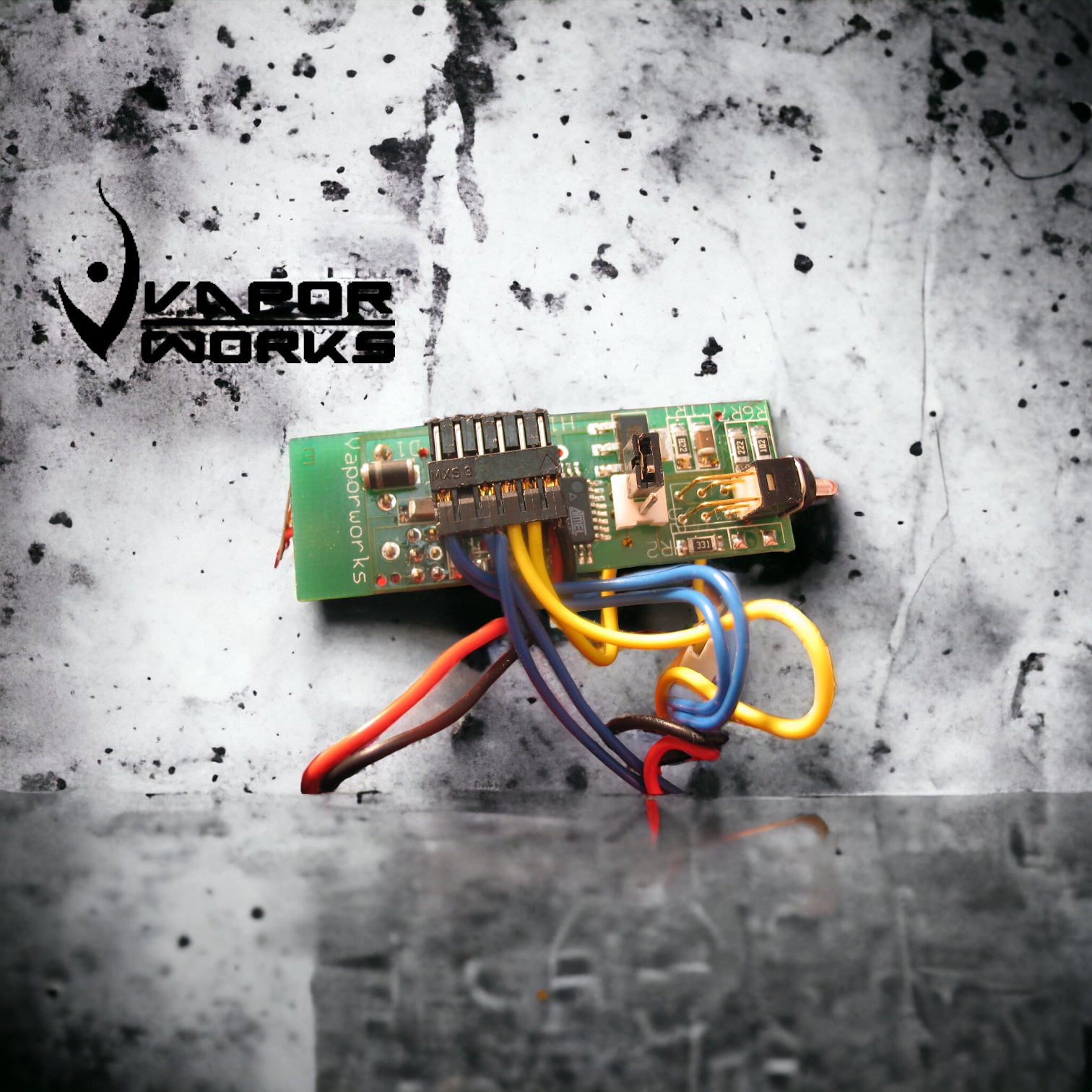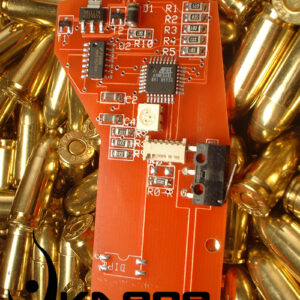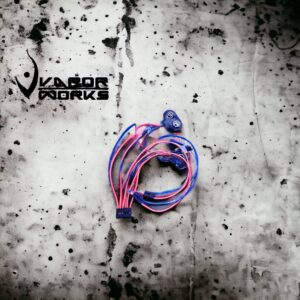Description
Please check the pictures of this board to make sure it will fit your marker.
The Chaos board controls the behavior of your marker based on settings that you can change. By changing the settings, you can tweak your marker to perform the way you want it to. The options and settings below correspond to Version 3.1 of the board firmware. If your board does not have Version 3.1, please use the appropriate manual for your firmware version.
Firing Mode: The firing mode setting lets you select between different firing modes:
Firing Modes:
| Semi-automatic | Fires one ball for each trigger pull. |
| Turbo | Alternates between firing one and two balls for each trigger pull Auto response Fires one ball for each trigger pull, and another ball upon trigger release |
| Full-automatic | Fires balls continuously until the trigger is released |
| PSP Ramping | Fires balls in accordance with PSP 2005 equipment rules. |
| NXL Ramping | Fires balls in accordance with NXL 2005 equipment rules. Snapshot Trainer Fires a maximum of four balls before requiring a wait time of two seconds. |
| True Ramp | Fires in Semi-Automatic until the Ramp Start BPS has been achieved, then adds shots up to the set ROF. |
| Off The Break 1 | Fires in Full Auto as long as trigger is held down when the board is first turned on. Once trigger is released, it fires in Semi-automatic for all pulls after that. |
| Off The Break 2 | Adds shots as long as trigger is pulled greater than Ramp Start BPS on boot. Once the trigger isn?t pulled for 1 second, it only shoots in Semi-automatic. |
Rate of Fire: The rate of fire determines the maximum number of balls per second (bps) that you can fire. You may set the rate of fire from 6 bps to unlimited bps. There is a secondary rate of fire control called AE Bypass ROF. This setting determines how fast you shoot if your maker automatically bypasses your eyes.
Dwell settings are a measurement of time. If you lower them, you shave off milliseconds, which in turn means it is entirely possible to achieve a few more balls per second.
Solenoid Dwell: The solenoid dwell is the length of time that the solenoid is energized for each shot. A short dwell time may not release enough gas to propel your paintball at proper velocity. A long dwell time may waste gas, and reduce your marker?s maximum rate of fire. The ideal dwell time for a solenoid depends on its make and model. It also depends on the solenoid?s age: a solenoid with a million cycles through it may need a longer dwell setting than a new solenoid. 8 ms is a good dwell time for new markers, and is the default setting of the Chaos Alias board. The solenoid dwell timing can be adjusted from 2.5 ms to 18.5 ms.
Anti-Bolt Stick Added Dwell: If the O-rings of a bolt are contaminated, the bolt may have difficulty moving if it has not been recently fired. The first shot will be at a lower velocity and may have trouble clearing your barrel. To counter this effect, the Anti-bolt Stick Added (ABS) Dwell setting lets you add a few additional milliseconds to the dwell timing of your first shot, but only if you have not fired your marker within the past 30 seconds. The ABS dwell setting can be adjusted from 0 ms to 10 ms.
Trigger Debounce: The trigger debounce value represents the strength of the electronic filtering applied to your trigger pull. Filtering the trigger signal is necessary, because the mechanical contacts in a trigger switch bounce several times before coming to rest. If we did not debounce the signal, your marker might register several phantom events for each actual trigger pull. The ideal debounce setting varies with the different makes and models of trigger switches. You must experiment to find the best setting for your particular switch. A marker with a debounce value that is too low has a tendency to double-fire, while a marker with a debounce value set too high experiences a reduction in its maximum rate of fire. The trigger debounce filter strength multiplier is adjustable from 3 to 30 via button programming, and from 1 to 30 via the V-link data cable.
Mechanical Debounce: The mechanical debounce filter counters mechanical trigger debounce. Increasing the strength of this filter reduces the likelihood of the recoil forces of your marker pulling the trigger for you. The mechanical debounce filter strength multiplier is adjustable from 0 to 15.
Ramp Start BPS: The ramp start bps is the setting at which shots will automatically be added into the firing stream to achieve the maximum
ROF set on the board as long as the trigger is continously activated faster than this speed. The ramp start BPS is adjustable from 6bps to 20bps.
Anti-Chop Eye Adjustments: Anti-chop eyes prevent the marker from firing if a paintball has not completely fallen into the chamber. This is good, because if you fire your marker while a portion of the paintball is still in the feed tube, the motion of the bolt will chop the paintball in half, sending paint into your hopper, your barrel, and the inner workings of your marker. Most paintball players would classify that as a bad thing.
The Chaos Alias board lets you customize several eye-related settings:
Disabling the Eyes: You can disable the anti-chop eyes. Your marker then acts as if eyes were never installed. With the eyes disabled, your maximum rate of fire is limited to 20 balls per second. Instructions on how to disable the eyes are presented in the next chapter.
Bypassing the Eyes: You can temporarily bypass the anti-chop eyes by holding down the trigger for two seconds. To re-enable the eyes, hold down the trigger for another two seconds. Manually bypassing the eyes will not lower your firing rate.
Automatic Eye Bypass: If the marker believes that your eyes are malfunctioning or are blocked by paint from a chopped paintball, the marker will automatically bypass the eyes and reduce your rate of fire to 12 balls per second.? Once you have cleared the eyes of paint and returned them to functioning status, the marker automatically resumes normal operation.
After Eye Delay: The after eye delay is the time, after the anti-chop eyes detect a paintball, that the marker waits before firing. This delay decreases your chances of chopping a paintball; a paintball may bounce a little when it falls into the chamber, or the eyes may have been drilled a little high and might detect paintballs before they have completely fallen into the chamber.The after eye delay is adjustable from 0 ms to 13 ms. Don?t leave broken paint in your marker. Paint may feel slippery like a lubricant, But it is actually an Abrasive suspension of Pigment particulates ? liquid sandpaper. You cannot manually bypass the eyes in automatic fire mode by holding down the trigger. Holding down the trigger in auto-fire mode does only one thing: spray lots and lots of paintballs! ? If you have a V-link data cable, you can change this value (known as the AE Bypass ROF) using the V-link Application software.
Eye Mode: The eye mode determines how the marker retests the eye condition after a paintball has loaded. There are three components to Eye Mode: bolt detection mode, SCOPE mode, eye timer mode. Bolt Detection Mode In the eye-monitored mode, the eye monitors the bolt position during the firing cycle to know when the bolt moves forward, back, and a ball is loaded. However, this mode only works for markers with eye systems that can see the bolt (break beam systems, or reflective eyes with a shiny, reflective bolt). In the bolt-timer mode, the system assumes that the bolt has completed its travel after a certain number of milliseconds. Use this mode if your eye system cannot see the bolt, or if you believe you can get better performance through manual timings. The default bolt timer value is 15 ms.
SCOPE Mode: Most of us have break-beam eye systems that work best with
- SCOPE On. This is the most chop-proof setting, and the one we recommend you use.
- SCOPE Off exists primarily for the seven or so people in the world who have reflective eye systems.
Eye Timer Mode: The eye timer mode determines whether the marker can fire paint even if the eyes do not detect a paintball. Most people will want to keep the eye timer mode set to Drop Shot After Timer. But, in markers with reflective eye systems or systems where the ball can roll out of the way, this mode lets the marker continue to fire at a rate of four balls per second until the eyes detect paint again.
AE Bypass ROF: The AE Bypass ROF is the rate of fire that the marker assumes if it is placed into eye bypass mode. The default value is 12 balls per second, but you may change this from 9 to 20 bps.



